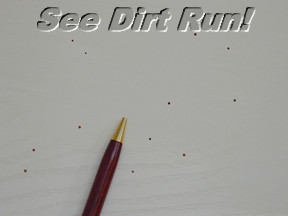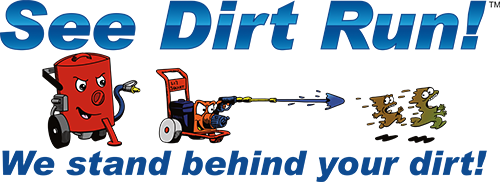Artillery Fungus on Vinyl and Aluminum Siding
Probably the two worst stains a home owner could discover on their siding are from artillery fungus or dried egg.The discovery of both of these stains tends to be too late in most cases. Egg is most successfully removed when it’s still wet, and artillery fungus can only be removed when the spores have just landed on the siding. Removing dried on egg is possible but it will leave a shadow behind.
At See Dirt Run!™ we have the ability to use cold, warm or hot water and low pressure to wash vinyl, aluminum, and brick homes with. This preserves the integrity of your siding. Think about it. You wash your dishes in warm or hot water don’t you? It’s a fact that warmer water gives you better results than cold water does.
Artillery fungus is tough to fight
 Gene Austin Philadelphia Inquirer March 3, 2001
Gene Austin Philadelphia Inquirer March 3, 2001
If your siding, car, fence or any other surfaces around your house have broken out with a rash of black or dark-brown specks that do not want to come off, you are probably at war with something called artillery fungus. It has become increasingly common in recent years, according to experts who have been seeking ways to control and eradicate it.
Artillery fungus, also called shotgun fungus or Sphaerobolus stellatus, usually originates in wood-chip mulch that is used around shrubs, flowers and other plants. Wet, rotting mulch breeds small mushrooms that shoot off spores for distances of up to 20 feet. The spores, which are sometimes mistaken for insect waste or bits of tar, cling tenaciously to surfaces such as house siding.
“It’s just like Super Glue,” said Don Davis, professor of plant pathology at Pennsylvania State University’s College of Agricultural Sciences. Davis and Larry Kuhns, professor of horticulture, have been leading a five-year study of the fungus, and they expect the study to continue for several more years. Davis said he gets 20 to 30 calls a week during the fungus’ most active seasons – generally spring and fall when temperatures range between 50 and 68 degrees. Callers are steered to Davis and Kuhns through the college’s Internet site: Artillery Fungus Information.
Davis said the rapid spread of the fungus and the growing number of fungus-damaged homes appear to be linked to the growing use of mulches made from recycled hardwood scraps and tree stumps.
Homeowners can take a key step to control artillery fungus by cleaning up wood-chip mulch around the house and disposing of it before the shooting starts again in April or May.
Here are some additional tips:
- Control. Bark mulch appears to be more resistant to the fungus than wood-chip mulch. Davis said pine-bark chunks seem to be the most resistant, and cedar, redwood and cypress mulch also appear to be resistant. “Even these mulches should be replaced every few years,” he said.
- Davis said stone mulch (usually small, decorative stones) “is the ultimate answer” to artillery fungus. Black plastic, held in place by stones or boards, is also safe, and some homeowners are getting good results with leaf mulch. Kuhns said fungicides do not work well because “it’s hard to determine when the mulch becomes infested, making the timing of the application . . . difficult.”
- Insurance. If your house is damaged by artillery fungus, check with the agent handling your homeowners insurance. Most policies do not cover damage from fungus or mildew, but some do. • Power-washing. Once the fungus becomes attached to a surface, even power-washing is not effective unless it is done within a few weeks of a fungal outbreak.
- One power-washing expert said he was able to remove the fungus using 200-degree water, with water pressure of 3,000 pounds per square inch, but this combination of hot water and high pressure can damage some types of siding.
- Scraping. Artillery fungus can be removed from windows by scraping with a razor blade. Scraping also can remove some of the black specks from smooth siding, but several homeowners who tried this reported that a brown residue remains and can’t be removed. Scraping can gouge vinyl and painted siding.
Our House Washing Service Areas
Serving: Maryland and Northern Virginia. Our service areas for Maryland are: Montgomery County, Frederick County, Howard County, Carroll County.
Cities in Maryland include: Potomac, Chevy Chase, Tacoma Park, Olney, Rockville, Bethesda, Kensington, Columbia, Clarksville, Silver Spring, Laytonsville, Mount Airy, New Market, Ijamsville, Gaithersburg, Montgomery Village, Germantown, Darnestown, Poolesville, Frederick, Urbana, Clarksburg, Barnesville, Brookville, Burtonsville, Cabin John, Damascus, Derwood, Kentlands, New Market, Sandy Spring, and Boyds.
Our service areas for Virginia are: Loudon County, Arlington County, Fairfax County, Ashburn, Leesburg, Alexandria, Herndon, McLean, Annandale, Arlington, Chantilly, Falls Church, Glen Echo, Great Falls, Oakton, Sterling, and Vienna. Contact our office today.
